Charles E W Bean, Diaries, AWM38 3DRL 606/251/1 - 1915 - 1936 - Part 15
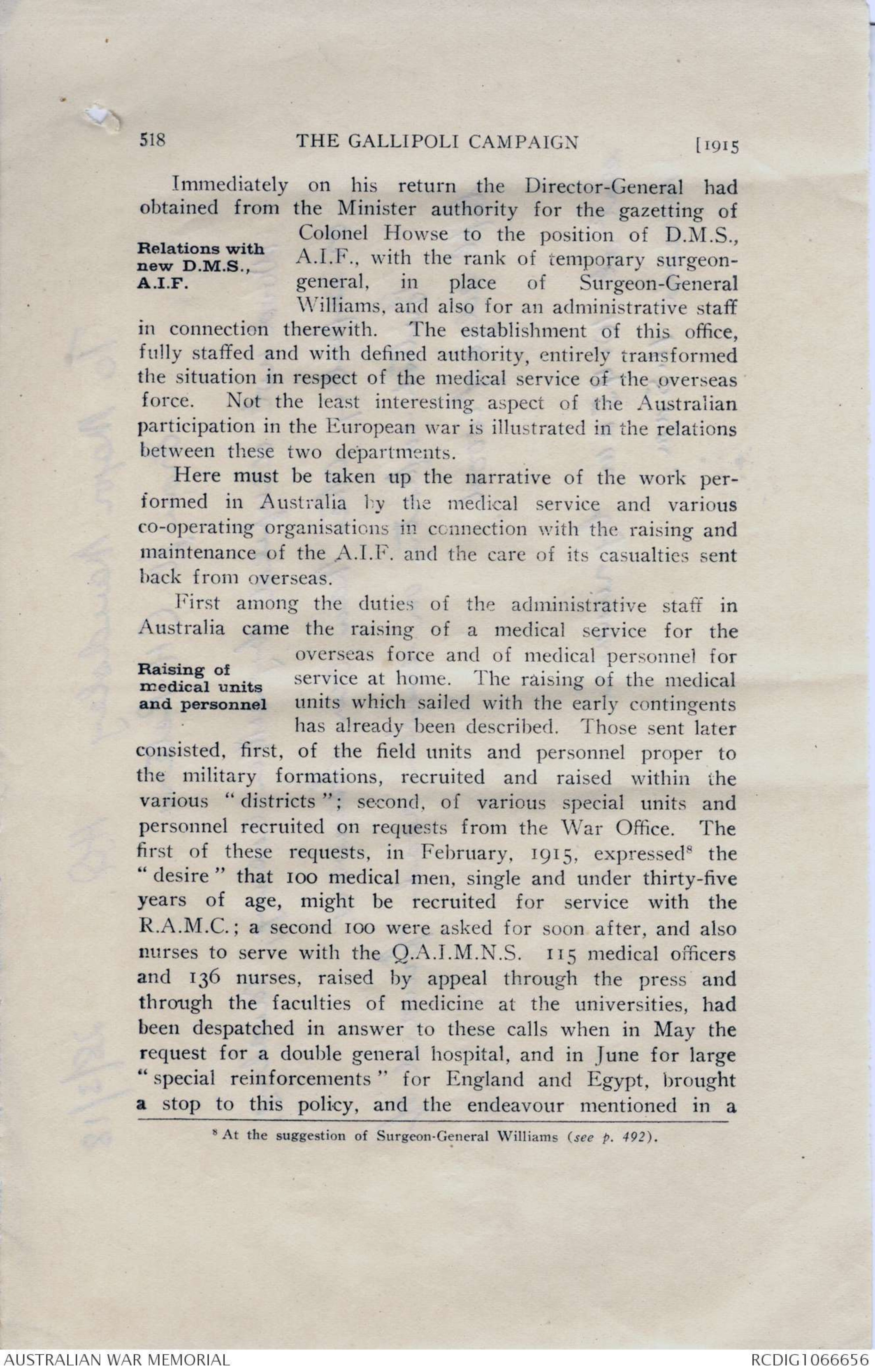
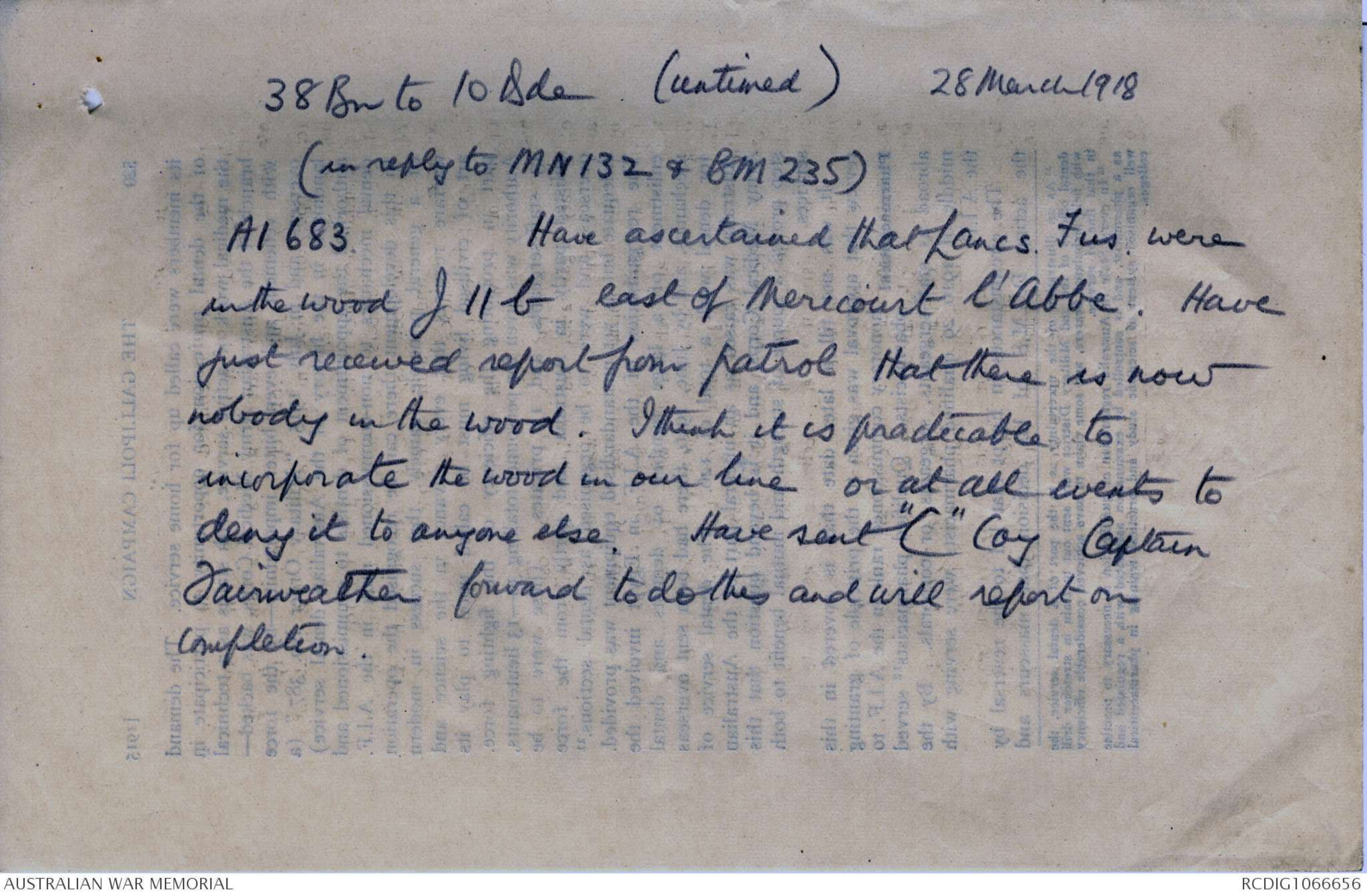
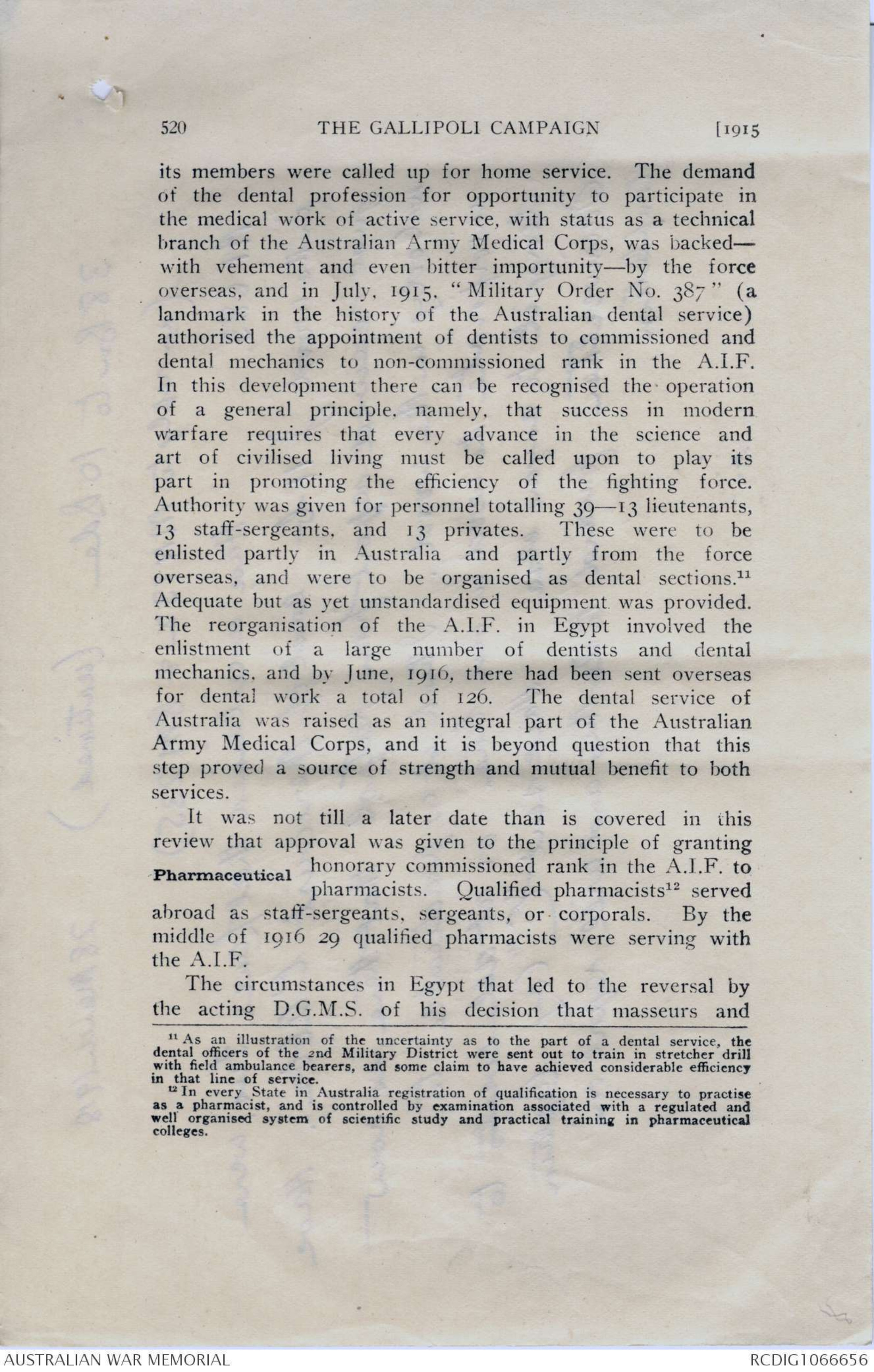

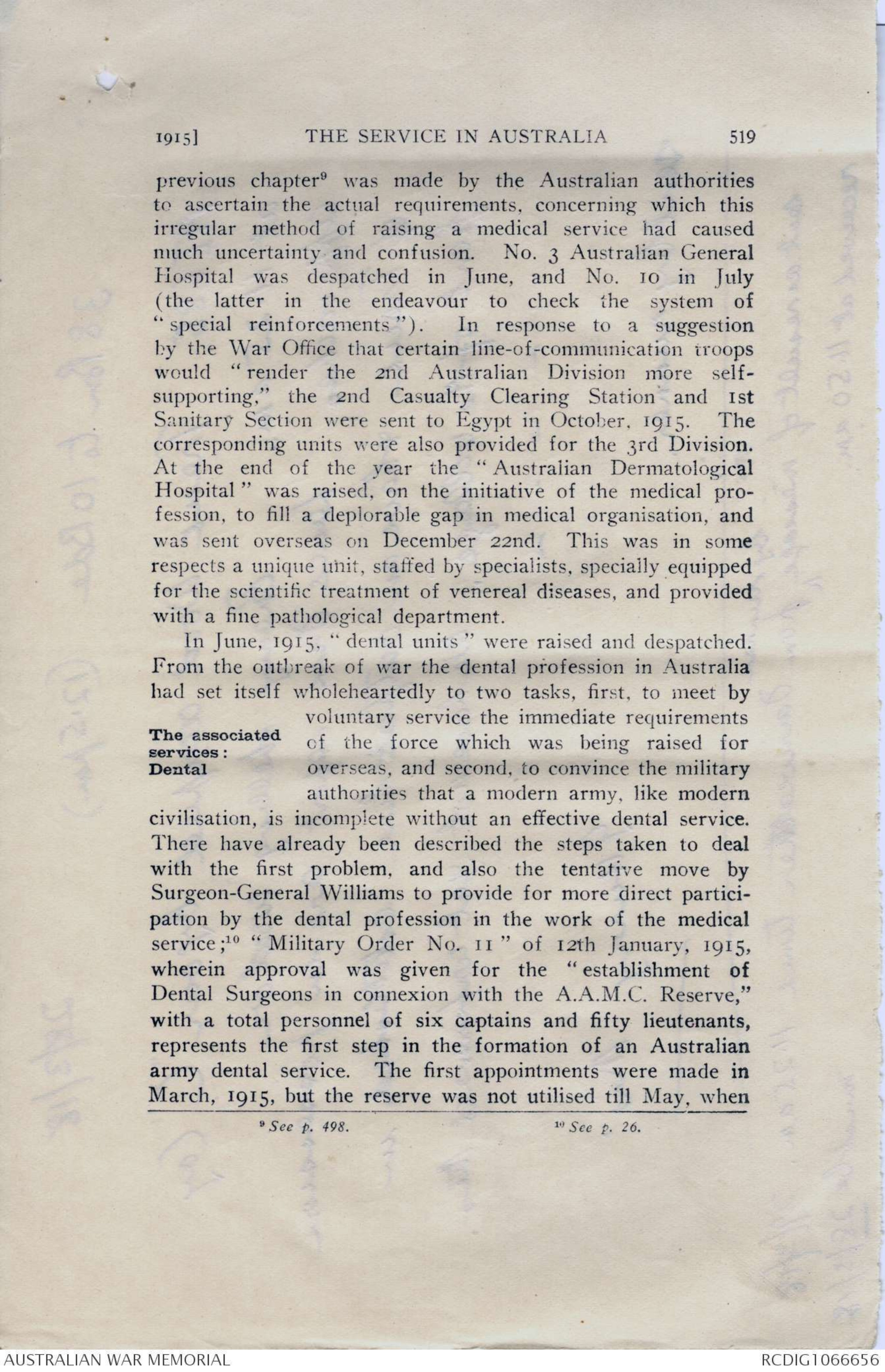
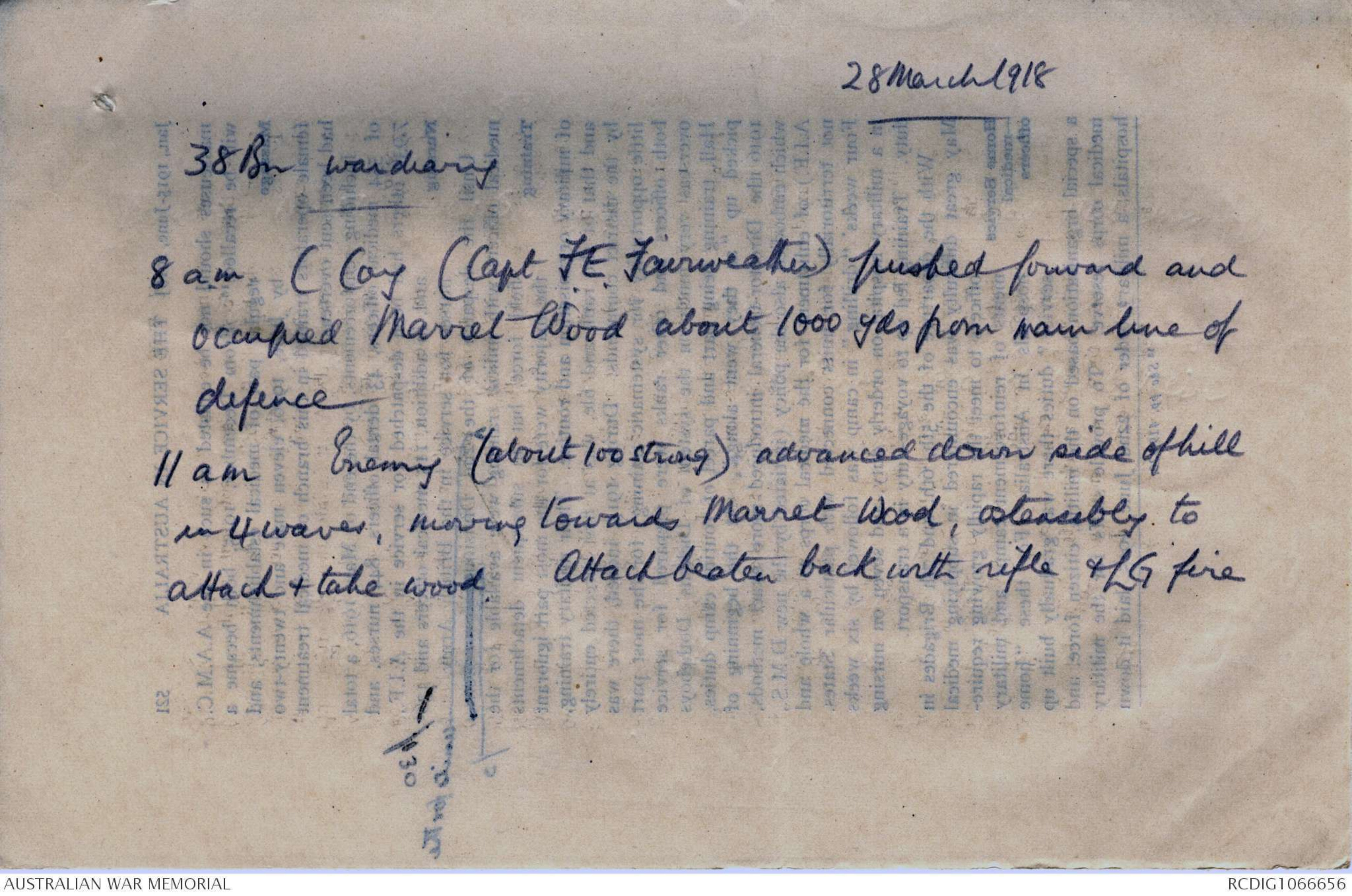
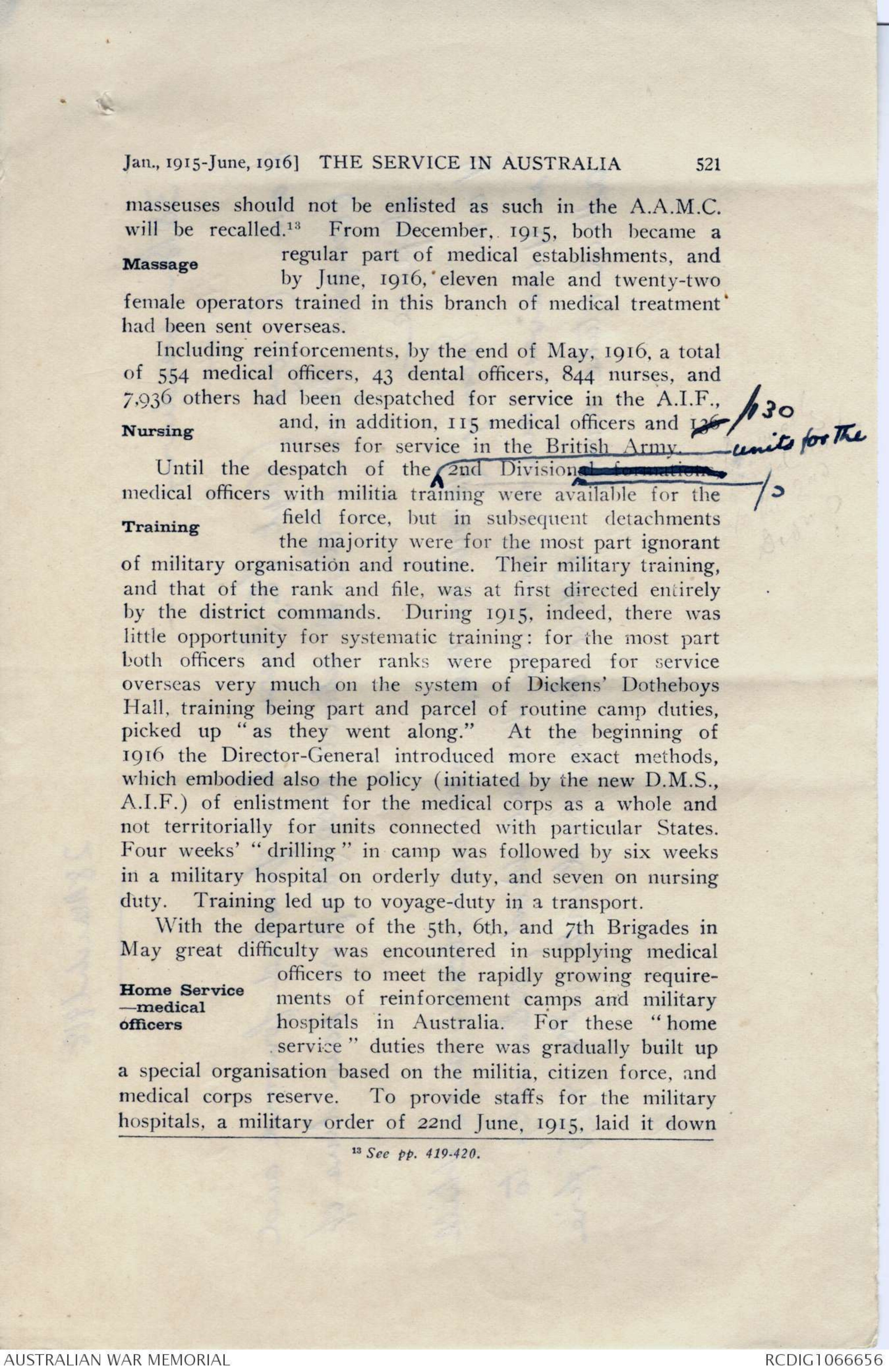
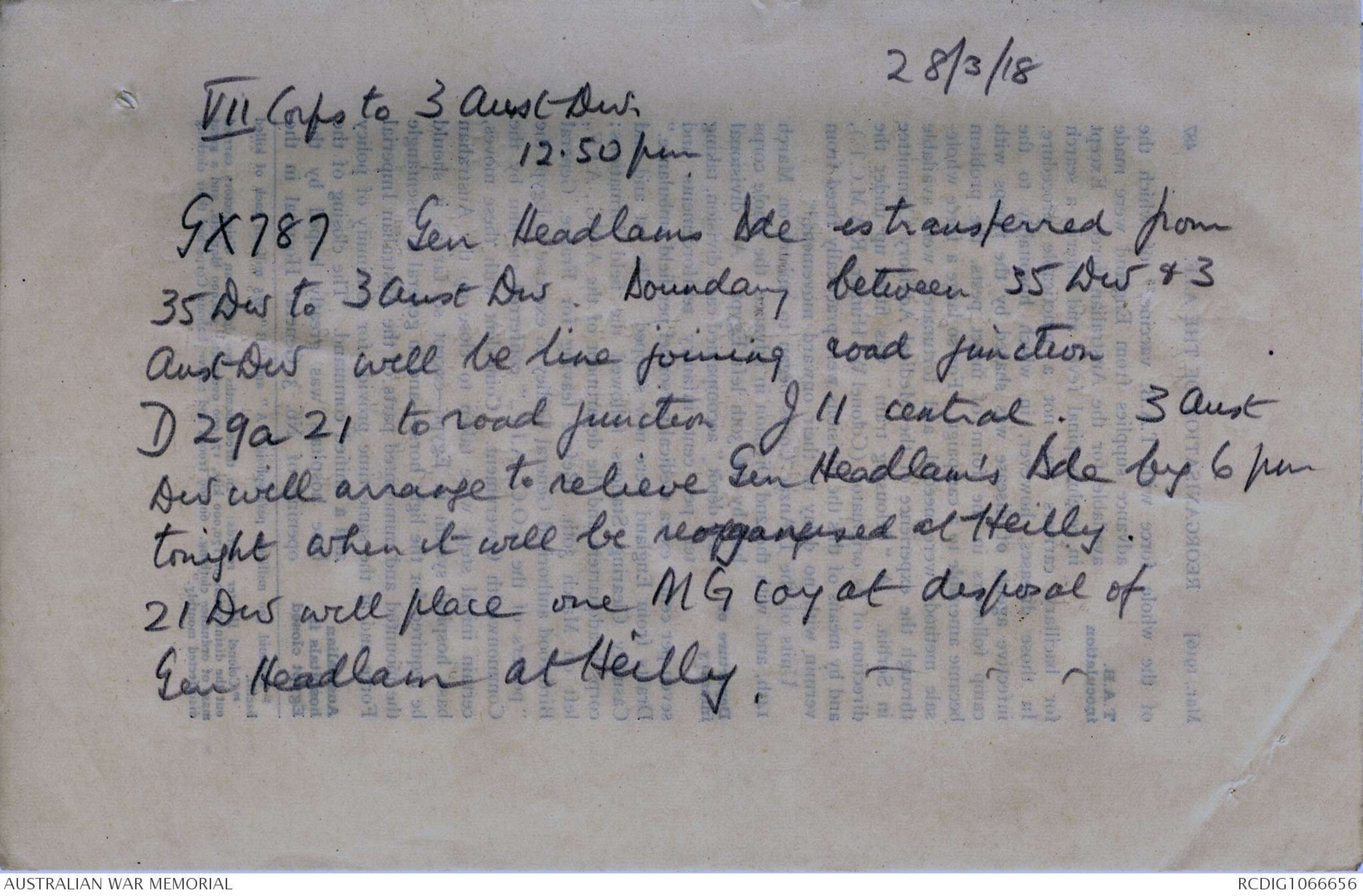
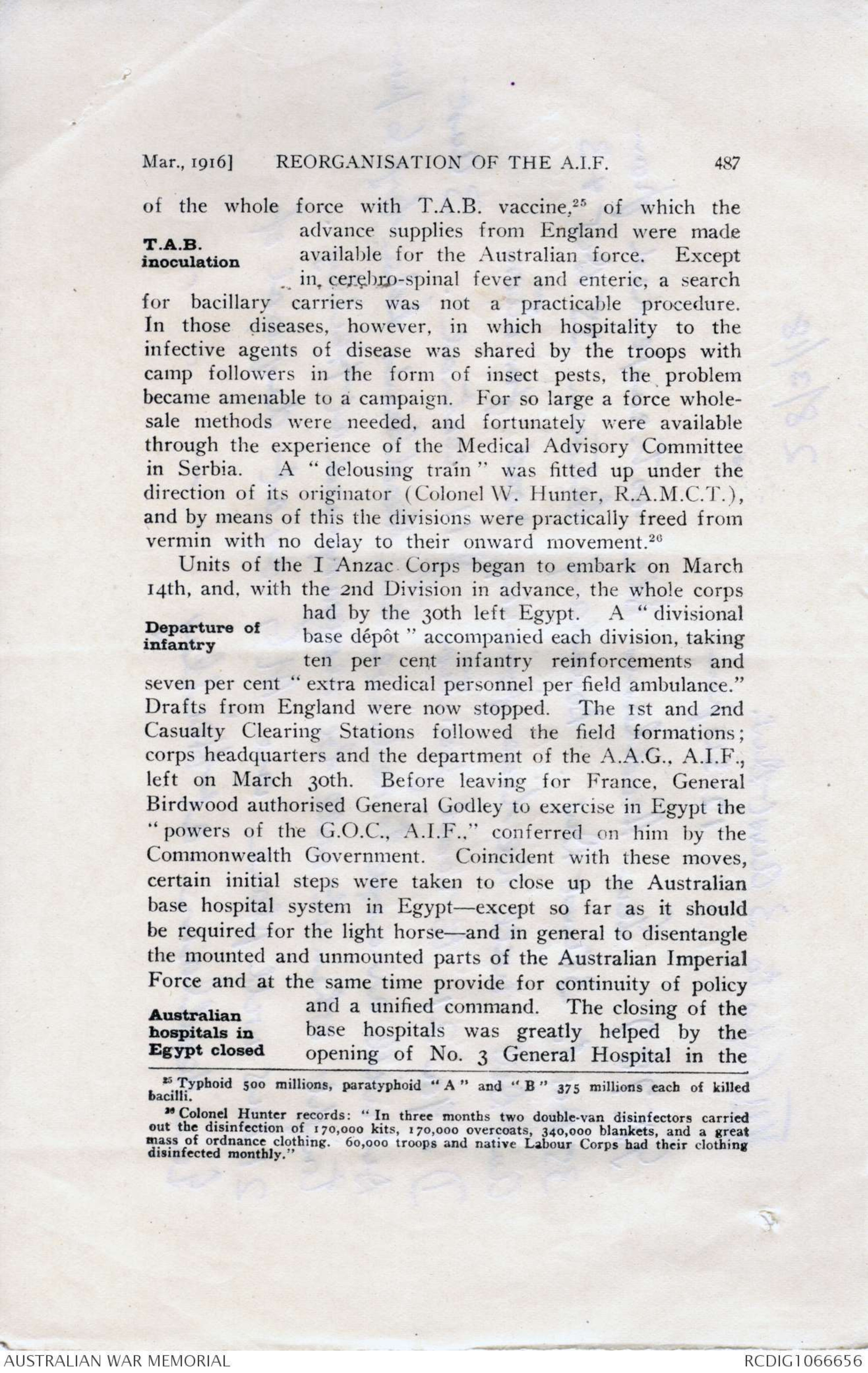

518 THE GALLIPOLI CAMPAIGN [1915
Immediately on his return the Director-General had
obtained from the Minister authority for the gazetting of
Colonel Howse to the position of D.M.S.,
Relations with
new D.M.S.,
A.I.F.
A.I.F., with the rank of temporary surgeon-general,
in place of Surgeon-General
Williams, and also for an administrative staff
in connection therewith. The establishment of this office,
fully staffed and with defined authority, entirely transformed
the situation in respect of the medical service of the overseas
force. Not the least interesting aspect of the Australian
participation in the European war is illustrated in the relations
between these two departments.
Here must be taken up the narrative of the work performed
in Australia by the medical service and various
co-operating organisations in connection with the raising and
maintenance of the A.I.F. and the care of its casualties sent
back from overseas.
First among the duties of the administrative staff in
Australia came the raising of a medical service for the
overseas force and of medical personnel for
Raising of
medical units
and personnel
service at home. The raising of the medical
units which sailed with the early contingents
has already been described. Those sent later
consisted, first, of the field units and personnel proper to
the military formations, recruited and raised within the
various "districts"; second, of various special units and
personnel recruited on requests from the War Office. The
first of these requests, in February, 1915, expressed8 the
"desire" that 100 medical men, single and under thirty-five
years of age, might be recruited for service with the
R.A.M.C.; a second 100 were asked for soon after, and also
nurses to serve with the Q.A.I.M.N.S. 115 medical officers
and 136 nurses, raised by appeal through the press and
through the faculties of medicine at the universities, had
been despatched in answer to these calls when in May the
request for a double general hospital, and in June for large
special reinforcements for England and Egypt, brought
a stop to this policy, and the endeavour mentioned in a
8At the suggestion of Surgeon General Williams (see p. 492).
38 Bn to 10 Bde. (untimed) 28 March 1918
(in reply to MN132 & BM235)
AI683 Have ascertained that Lancs. Fus. were
in the wood J 11 b east of Mericourt l'Abbe. Have
just received report from patrol that there is now
nobody in the wood. I think it is practicable to
incorporate the wood in our line or at all events to
deny it to anyone else. Have sent "C" Coy Captain
Fairweather forward to do this and will report or
completion.
520 THE GALLIPOLI CAMPAIGN [1915
its members were called up for home service. The demand
of the dental profession for opportunity to participate in
the medical work of active service, with status as a technical
branch of the Australian Army Medical Corps, was backed—
with vehement and even bitter importunity—by the force
overseas, and in July, 1915. "Military Order No. 387" (a
landmark in the history of the Australian dental service
authorised the appointment of dentists to commissioned and
dental mechanics to non-commissioned rank in the A.l.F.
In this development there can be recognised the operation
of a general principle, namely, that success in modern
warfare requires that every advance in the science and
art of civilised living must be called upon to play its
part in promoting the efficiency of the fighting force.
Authority was given for personnel totalling 39—13 lieutenants,
13 staff-sergeants, and 13 privates. These were to be
enlisted partly in Australia and partly from the force
overseas, and were to be organised as dental sections.11
Adequate but as yet unstandardised equipment was provided.
The reorganisation of the A.L.F. in Egypt involved the
enlistment of a large number of dentists and dental
mechanics, and by June, 1916, there had been sent overseas
for dental work a total of 126. The dental service of
Australia was raised as an integral part of the Australian
Army Medical Corps, and it is beyond question that this
step proved a source of strength and mutual benefit to both
services.
It was not till a later date than is covered in this
review that approval was given to the principle of granting
honorary commissioned rank in the A.I.F. to
Pharmaceutical
pharmacists. Qualified pharmacists12 served
abroad as staff-sergeants, sergeants, or corporals. By the
middle of 1916 29 qualified pharmacists were serving with
the A.I.F.
The circumstances in Egypt that led to the reversal by
the acting D.G.M.S. of his decision that masseurs and
11 As an illustration of the uncertainty as to the part of a dental service, the
dental officers of the 2nd Military District were sent out to train in stretcher drill
with field ambulance bearers, and some claim to have achieved considerable efficiency
in that line of service.
12 In every State in Australia registration of qualification is necessary to practise
as a pharmacist, and is controlled by examination associated with a regulated and
well organised system of scientific study and practical training in pharmaceutical
colleges.
38Bn to 10Bde (12.5 pm) 28/3/18
AI685. Treux Wood occupied by our "C" Coy
at 11.25am. Enemy shelling wool or
approaches. Lancs Fus report are in possession
of Treux & have an outpost line established in
front of the village. We have not yet confirmed this.
G Hurry Maj
sent by runner.
sent as a result of message ^by runner from Fairweather timed 11.25 a.m. 29/3/18
received at 11.50 am must be 28/3/18
1915] THE SERVICE IN AUSTRALIA 519
previous chapter9 was made by the Australian authorities
to ascertain the actual requirements, concerning which this
irregular method of raising a medical service had caused
much uncertainty and confusion. No. 3 Australian General
Hospital was despatched in June, and No. 10 in July
(the latter in the endeavour to check the system of
"special reinforcements"). In response to a suggestion
by the War Office that certain line-of-communication troops
would "render the and Australian Division more self-supporting,"
the 2nd Casualty Clearing Station and 1st
Sanitary Section were sent to Egypt in October, 1915. The
corresponding units were also provided for the 3rd Division.
At the end of the year the "Australian Dermatological
Hospital" was raised, on the initiative of the medical profession,
to fill a deplorable gap in medical organisation, and
was sent overseas on December 22nd. This was in some
respects a unique unit, staffed by specialists, specially equipped
for the scientific treatment of venereal diseases, and provided
with a fine pathological department.
In June, 1915, "dental units" were raised and despatched.
From the outbreak of war the dental profession in Australia
had set itself wholeheartedly to two tasks, first, to meet by
voluntary service the immediate requirements
The associated
services:
Dental
of the force which was being raised for
overseas, and second, to convince the military
authorities that a modern army, like modern
civilisation, is incomplete without an effective dental service.
There have already been described the steps taken to deal
with the first problem, and also the tentative move by
Surgeon-General Williams to provide for more direct participation
by the dental profession in the work of the medical
service;10 "Military Order No. 11" of 12th January, 1915,
wherein approval was given for the "establishment of
Dental Surgeons in connexion with the A.A.M.C. Reserve,"
with a total personnel of six captains and fifty lieutenants,
represents the first step in the formation of an Australian
army dental service. The first appointments were made in
March, 1915, but the reserve was not utilised till May, when
9See p. 498. 10See p. 26.
28 March 1918
38 Bn war diary
8 am C Coy (Capt. F.E. Fairweather) pushed forward and
occupied Marret Wood about 1000 yds from main line of
defence
11am Enemy (about 100 strong) advanced down side of hill
in 4 waves, moving towards Marret Wood, ostensibly to
attack & take wood. Attack beaten back with rifle & LG fire
1
Jan., 1915-June, 1916) THE SERVICE IN AUSTRALIA 521
masseuses should not be enlisted as such in the A.A.M.C.
will be recalled. 13 From December, 1915, both became a
regular part of medical establishments, and
Massage
by June, 1916, "eleven male and twenty-two
female operators trained in this branch of medical treatment"
had been sent overseas.
Including reinforcements, by the end of May, 1916, a total
of 554 medical officers, 43 dental officers, 844 nurses, and
7,936 others had been despatched for service in the A.I.F
and, in addition, 115 medical officers and 136 [*130*]
Nursing
nurses for service in the British Army.
Until the despatch of the ^units for the 2nd Divisionsal formation
medical officers with militia training were available for the
field force, but in subsequent detachments
Training
the majority were for the most part ignorant
of military organisation and routine. Their military training
and that of the rank and file, was at first directed entirely
by the district commands. During 1915, indeed, there was
little opportunity for systematic training: for the most part
both officers and other ranks were prepared for service
overseas very much on the system of Dickens' Dotheboys
Hall, training being part and parcel of routine camp duties,
picked up "as they went along." At the beginning of
1916 the Director-General introduced more exact methods,
which embodied also the policy (initiated by the new D.M.S.,
A.I.F.) of enlistment for the medical corps as a whole and
not territorially for units connected with particular States.
Four weeks’ "drilling" in camp was followed by six weeks
in a military hospital on orderly duty, and seven on nursing
duty. Training led up to voyage-duty in a transport.
With the departure of the 5th, 6th, and 7th Brigades in
May great difficulty was encountered in supplying medical
officers to meet the rapidly growing requirements
Home Service
-medical
officers
of reinforcement camps and military
hospitals in Australia. For these "home
service" duties there was gradually built up
a special organisation based on the militia, citizen force, and
medical corps reserve. To provide staffs for the military
hospitals, a military order of 22nd June, 1915, laid it down
13 See pp. 419-420.
28/3/18
VII Corps to 3 Aust. Div.
12.50 pm
GX787 Gen Headlams Bde is transferred from
35 Div to 3 Aust Div. Boundary between 35 Div & 3
Aust Div will be line joining road junction
D 29a 21 to road junction J 11 central. 3 Aust
Div will arrange to relieve Gen Headlam's Bde by 6 pm
tonight when it will be reorganised at Heilly.
21 Div will place one MG coy at disposal of
Gen Headlam at Heilly.
Mar., 1916) REORGANISATION OF THE A.I.F. 487
of the whole force with T.A.B. vaccine, 25 of which the
advance supplies from England were made
T.A.B.
inoculation
available for the Australian force. Except
in, cerebro-spinal fever and enteric, a search
for bacillary carriers was not a practicable procedure.
In those diseases, however, in which hospitality to the
infective agents of disease was shared by the troops with
camp followers in the form of insect pests, the problem
became amenable to a campaign. For so large a force wholesale
methods were needed, and fortunately were available
through the experience of the Medical Advisory Committee
in Serbia. A "delousing train" was fitted up under the
direction of its originator (Colonel W. Hunter, R.A.M.C.T.),
and by means of this the divisions were practically freed from
vermin with no delay to their onward movement.26
Units of the I Anzac Corps began to embark on March
14th, and, with the 2nd Division in advance, the whole corps
had by the 30th left Egypt. A "divisional
Departure of
infantry
base dépôt" accompanied each division, taking
ten per cent infantry reinforcements and
seven per cent "extra medical personnel per field ambulance."
Drafts from England were now stopped. The 1st and 2nd
Casualty Clearing Stations followed the field formations;
corps headquarters and the department of the A.A.G., A.I.F.
left on March 30th. Before leaving for France, General
Birdwood authorised General Godley to exercise in Egypt the
"powers of the G.O.C., A.I.F.," conferred on him by the
Commonwealth Government. Coincident with these moves,
certain initial steps were taken to close up the Australian
base hospital system in Egypt—except so far as it should
be required for the light horse—and in general to disentangle
the mounted and unmounted parts of the Australian Imperial
Force and at the same time provide for continuity of policy
and a unified command. The closing of the
Australian
hospitals in
Egypt closed
base hospitals was greatly helped by the
opening of No. 3 General Hospital in the
25 Typhoid 500 millions, paratyphoid "A" and "B" 375 millions each of killed
bacilli.
26 Colonel Hunter records: "In three months two double-van disinfectors carried
out the disinfection of 170,000 kits, 170,000 overcoats, 340,000 blankets, and a great
mass of ordnance clothing. 60,000 troops and native Labour Corps had their clothing
disinfected monthly."
28/3 28 March 1918.
10 Bde to Ayc (13 Div)
No. BM 246. 1.15pm
Confirming telephone message ^recd at 3 Div 12.55pm. At 12.20 enemy
reported massing on ridge near track about M in Morlancourt
on 1/10,000 map. Have communicated with 198 Army
Bde Arty at D 21 c 93. 37Bn have matter in
hand. 38 Bn have occupied Trieux Wood with
one company at 11.25 a.m. 38th also report Lancs
Fus. in possession on Trieux village with outposts in front.
This as not yet confirmed.
This transcription item is now locked to you for editing. To release the lock either Save your changes or Cancel.
This lock will be automatically released after 60 minutes of inactivity.